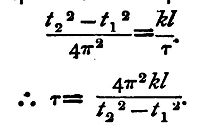| Practical Physics is a free textbook on basic laboratory physics. See the editorial for more information.... |

|

Home  Mechanics of Solids Mechanics of Solids  Modulus of Torsion of a Wire Modulus of Torsion of a Wire |
|||||






|
|||||
Modulus of Torsion of a Wire
If the wire contain l units of length, and the end be twisted through a unit angle, each unit of length is twisted through an angle 1/l, and the couple required to do this is τ/l where τ is the modulus of torsion of the wire. The couple required to twist unit length through an angle θ τθ, that required to twist a length l through an angle θ is τθ/l. Suppose a mass, whose moment of inertia1 is K, is fixed rigidly to the wire, which is then twisted, the mass will oscillate, and if t1 sec. be the time of a complete oscillation, it can be shown that
To find τ, then, we require to measure t1 and K. K can be calculated if the body be one of certain determinate shapes. If not, we may proceed thus: We can alter the moment of inertia of the system without altering the force tending to bring the body, when displaced, back to its position of equilibrium either (1) by suspending additional masses of known shape, whose moment of inertia about the axis of rotation can be calculated, or (2) by altering the configuration of the mass with reference to the axis of rotation. Suppose that in one of these two ways the moment of inertia is changed from K to K+k, where the change k in the moment of inertia can be calculated, although K cannot. Observe the time of swing again. Let it be t2. Then
Thus
Whence
Thus τ can be expressed in terms of the observed quantities t1, t2 and l, and the quantity k which can be calculated. We proceed to give the experimental details of the application of this method of finding the modulus of torsion of a wire by observing the times of vibration, t1, t2, when the moments of inertia of the suspended mass are K and K+k respectively. The change in the moment of inertia is produced on the plan numbered (2) above, by a very convenient piece of apparatus devised by Maxwell, and described in his paper on the Viscosity of Gases.
|
|||||
Home  Mechanics of Solids Mechanics of Solids  Modulus of Torsion of a Wire Modulus of Torsion of a Wire |
|||||
Last Update: 2011-03-19









